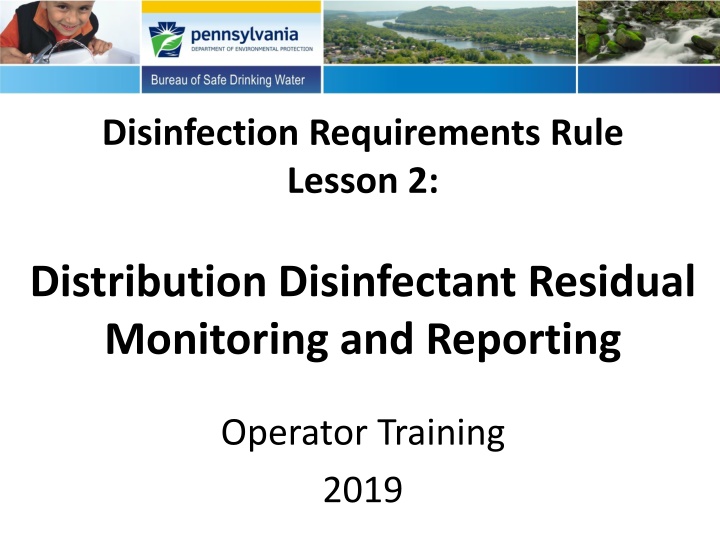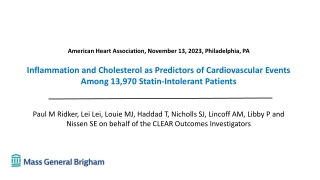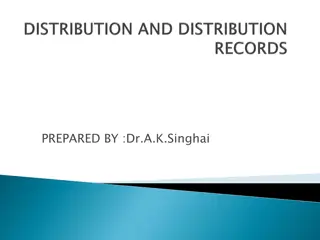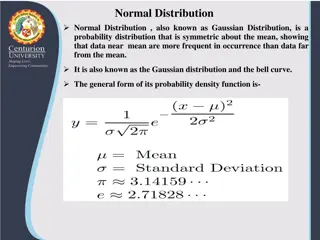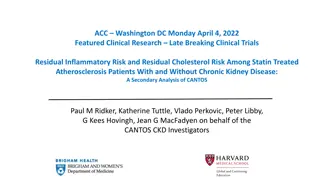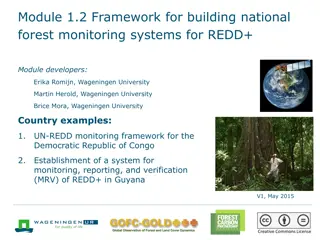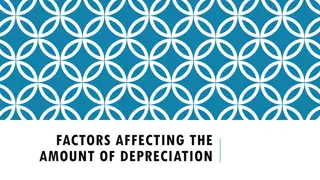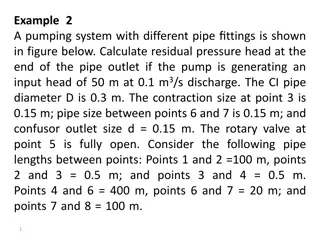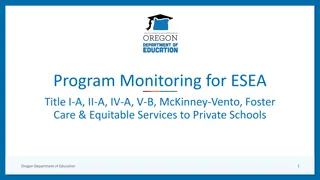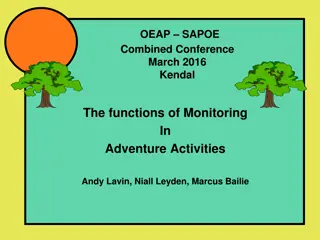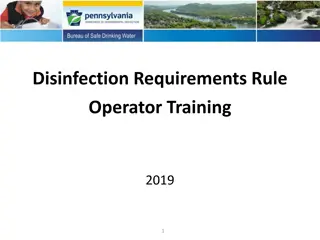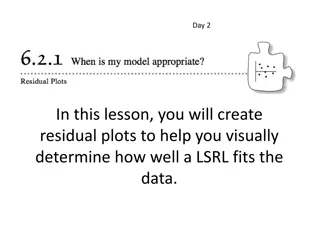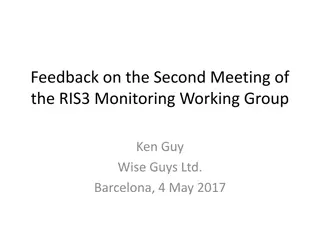Distribution Disinfectant Residual Monitoring Requirements
This content focuses on the monitoring requirements for distribution disinfectant residual as per the Disinfection Requirements Rule Lesson 2. It covers the type of monitoring needed, applicability to water systems, effective dates, and monitoring guidelines to ensure compliance. Learn about the types of disinfectants, reporting procedures, and essential monitoring protocols.
Uploaded on Feb 15, 2025 | 2 Views
Download Presentation

Please find below an Image/Link to download the presentation.
The content on the website is provided AS IS for your information and personal use only. It may not be sold, licensed, or shared on other websites without obtaining consent from the author.If you encounter any issues during the download, it is possible that the publisher has removed the file from their server.
You are allowed to download the files provided on this website for personal or commercial use, subject to the condition that they are used lawfully. All files are the property of their respective owners.
The content on the website is provided AS IS for your information and personal use only. It may not be sold, licensed, or shared on other websites without obtaining consent from the author.
E N D
Presentation Transcript
Disinfection Requirements Rule Lesson 2: Distribution Disinfectant Residual Monitoring and Reporting Operator Training 2019
Objectives Determine what type of disinfectant residual monitoring is required Describe the distribution disinfectant residual Monitoring Requirements under the DRR Properly report distribution disinfectant residual results under the DRR WB 2-1
Applicability What water systems need to comply with the DRR monitoring requirements? CWS NTNC using chlorine or chloramines (or purchase water from a system using chlorine or chloramines) TNC using SW/GUDI sources TNC with GWR 4-log treatment of viruses WB 2-1
Effective Date When do the distribution residual monitoring requirements of the DRR go into effect? 1 year after the effective date of the rule: April 29, 2019 APRIL 2019 Sun Mon Tues Wed Thurs Fri Sat 1 2 3 4 5 6 7 8 9 10 11 12 13 14 15 16 17 18 19 20 21 22 23 24 25 26 27 28 29 30 DRR WB 2-1
Type of monitoring What type of monitoring is required? Free chlorine for systems using chlorine Total chlorine for systems using chloramines Both free and total chlorine for mixing zones (identified in SSP) Both free and total chlorine during a free chlorine burn (for systems using chloramine) WB 2-1
Type of monitoring What is a mixing zone? System B Chlorine System A Chloramines Treatment Bldg. Treatment Bldg. Mixing Zone Monitor both free and total chlorine WB 2-1
Monitoring What are the chorine and chloramine distribution residual monitoring requirements? Monitor in accordance with DRR sample siting plan Monitor at the same time and from the same location as RTCR samples Monitor from representative locations in the distribution system at least once per week NEW Monitor during normal operating conditions WB 2-2
Sample Siting Plan Monitor per Sample Siting Plan (SSP) for DRR Was due 6 months after effective date of DRR (Oct. 29, 2018) 109.701(a)(8) lists required elements to be included Addendum to RTCR plan monitoring required with all RTCR samples Addendum D contains all required elements for SSP Used to identify representative locations for monitoring disinfectant residuals 1. General Distribution Location 2. Dead ends 3. First service connection 4. Finished water storage tanks 5. Interconnections with other systems 6. Areas of high water age 7. Previous coliform detections 8. Mixing zones Also used to identify a monitoring schedule at each location Which week of each month WB 2-2
Weekly Monitoring Monitor at least once per week (Sunday to Saturday) July 2019 Sun Mon Tues Wed Thurs Fri Sat 1 2 3 4 5 6 Week 1 Week 1 7 8 9 10 11 Week 2 12 13 Week 2 14 15 16 Week 3 17 18 Week 3 19 20 21 22 23 Week 4 24 25 Week 4 26 27 Aug 1 3 2 28 29 30 Week 5 31 Week 1 WB 2-3
Weekly Monitoring 28 29 30 31 Aug 1 2 3 Week 1 Week 5 4 5 6 7 8 9 10 Week 2 Week 1 11 12 13 14 15 16 17 Week 2 Week 3 18 19 20 21 22 23 24 Week 3 Week 4 25 26 27 28 29 30 31 Week 5 Week 4 Sept 1 2 3 4 5 6 7 Week 1 Week 1 WB 2-3
Monitoring Reminder: Still need to monitor the correct number of samples per month! Ex. If need 10 samples per month, can t just monitor 2 per week in months with only 4 weeks JUNE 2019 JUNE 2019 SUN SUN MON MON TUES TUES WED WED THUR THUR FRI FRI SAT SAT 1 1 2 samples 2 2 3 3 3 samples 4 4 5 Only 8 samples this month! 19 20 26 27 5 6 6 7 7 8 8 9 9 10 2 samples 10 3 samples 11 11 12 12 13 13 14 14 15 15 16 16 17 2 samples 17 2 samples 18 18 19 20 21 21 22 22 23 23 24 2 samples 24 2 samples 25 25 26 27 28 28 29 29 30 30 WB 2-4
Weekly Monitoring Monitor at least once per week Not necessary to monitor the same day of each week July 2019 Sun Mon Tues Wed Thurs Fri Sat 1 2 3 4 5 6 Week 1 Week 1 7 8 9 10 11 Week 2 12 13 Bottom Line: Be sure to sample 14 each week from Sunday to Saturday! 15 16 17 18 Week 3 19 20 21 22 23 24 25 Week 4 26 Week 4 27 28 29 30 31 Week 5 Aug 1 Week 1 2 3 WB 2-5
Weekly Monitoring Must monitor at representative locations in the distribution system at least once per week May need more than one sample per week in order to be representative SSP should have already identified a representative monitoring plan Why might more than one sample per week be needed? Multiple distribution systems WB 2-5
Crystal Lake Manufactured Housing Community Population: 400 701 2 distribution mains Well #1 Treatment Bldg. North Court: 75 connections 6 main Crystal Lake South Court: 100 connections Well #2 Treatment Bldg. 702 6 main 2 distribution mains RTCR monitoring locations : 701 and 702 Monitor both locations every month in order to be representative, according to their RTCR SSP: 701 during first week of the month 702 during third week of the month
Crystal Lake Manufactured Housing Community RTCR monitoring locations: 701 and 702 July 2019 Sun Mon Tues Wed Thurs Fri Sat 1 2 3 4 5 6 701 702 7 8 9 10 11 12 13 701 702 Coliform and chlorine residual monitoring 701 14 15 16 17 18 19 20 702 702 701 21 22 23 24 25 26 27 701 701 702 Chlorine residual monitoring only 702 28 29 30 701 702
Monitoring Other monitoring requirements: For any individual sites that do not maintain the minimum residual in any given month, those sites must be included in monitoring the following month 0.2 mg/L What is the minimum? NOTE: This is in addition to the monitoring outlined in the sample siting plan (unless the same sites are monitored each month) WB 2-5
Crystal Lake Manufactured Housing Community Collect 2 total coliform samples per month RTCR monitoring locations: 701 and 702 July 2019 Sun Mon Tues Wed Thurs Fri Sat 1 2 3 4 5 6 701 702 7 8 9 10 11 12 13 701 702 Coliform and chlorine residual monitoring 701 14 15 16 17 18 19 20 702 702 701 0.12 mg/L 21 22 23 24 25 26 27 701 701 702 Chlorine residual monitoring only 702 28 29 30 701 702
Crystal Lake Manufactured Housing Community Following month: No additional monitoring needed already monitor at 701 August 2019 Sun Mon Tues Wed Thurs Fri Sat 1 2 3 4 5 6 7 8 9 10 11 701 702 Coliform and chlorine residual monitoring 701 12 13 14 15 16 17 18 701 702 702 19 20 21 22 23 24 25 702 701 701 Chlorine residual monitoring only 702 26 27 28 29 30 31 701 702
Woodview Municipal Water System Collect 2 total coliform samples per month RTCR monitoring locations: 701, 702, 703, 704 Alternate between 701 & 702, and 703 & 704 July 2019 Sun Mon Tues Wed Thurs Fri Sat 1 2 3 4 5 6 701 702 7 8 9 10 11 12 13 701 702 Coliform and chlorine residual monitoring 701 14 15 16 17 18 19 20 702 702 701 0.12 mg/L 21 22 23 24 25 26 27 701 701 702 Chlorine residual monitoring only 702 28 29 30 701 702 WB 2-6
Woodview Municipal Water System Following month: Need to add a chlorine sample at location ID 701! August 2019 Sun Mon Tues Wed Thurs Fri Sat 1 2 3 4 5 6 7 8 9 10 11 703 701 704 Coliform and chlorine residual monitoring 703 12 13 14 15 16 17 18 703 704 704 19 20 21 22 23 24 25 704 703 703 Chlorine residual monitoring only 704 26 27 28 29 30 31 703 704 WB 2-6
Monitoring online analyzers Other monitoring requirements: May substitute online monitoring and recording in the distribution system for grab monitoring Recording frequency not specified by DRR Part of SSP information When might online monitoring be used? Storage tank effluents Pump stations Auto-flushing Online instrumentation must be validated per 109.304 WB 2-7
Monitoring who can monitor? Who can conduct disinfectant residual monitoring? Same as any other ABR parameter, per 109.304(c): A Certified operator A person operating under a Standard Operator Procedure (SOP) approved by a certified operator An environmental laboratory Must follow approved analytical techniques, per 109.304(a) WB 2-7
Monitoring EPA Method 334.0 EPA Method 334.0 Quality Control protocol ensures accurate measurements of free and total chlorine residuals Both the analyst(s) and any equipment used for compliance monitoring must follow Method 334.0 Resources: Fact sheet (handout) https://www.dep.pa.gov/Business/Water/BureauSafeDrinkingWater/DrinkingWaterMgmt/Pages/Method-334.0.aspx https://www.dep.pa.gov/Business/Water/BureauSafeDrinking Water/DrinkingWaterMgmt/Pages/Method-334.0.aspx Webpage: WB 2-7
Knowledge Check Activity Monitoring Requirements System #1: Give it a Chai Tearoom TNC with 4-log treatment, population 100. One building, food/beverage prep, dish- and hand-washing. WB 2-8
Knowledge Check 1. Is Give it a Chai required to comply with the DRR monitoring requirements? Why or why not? Yes it is a TNC with 4-log treatment of a GW source 2. If so, what type of monitoring is required (free chlorine, total chlorine, or both)? Free chlorine WB 2-8
Knowledge Check 3. How many disinfectant residual samples must the collect per month for DRR? Per week? At least 4 per month (due to weekly sampling) At least 1 per week July 2 July 9 July 16 July 23 July 30 0.25 mg/L 0.21 mg/L 0.18 mg/L 0.13 mg/L 0.24 mg/L 4. Is any additional monitoring required in August? No they have a low result at 701, but they already monitor at 701 every month WB 2-8
Knowledge Check System #2: Black Bear Borough CWS with GW sources, hypochlorite treatment, population 4,500 (minimum of 5 RTCR samples based on population). Also purchase treated water via interconnection with neighboring system, Woodstown Area Authority, which uses chloramines in their distribution system. WB 2-9
Knowledge Check 5. What type of disinfectant monitoring is required by Black Bear water system? Free chlorine in the area treated with chlorine, total chlorine in the area with chloramines, and both free and total chlorine in the mixing zone (identified in their SSP) 6. How many distribution disinfectant samples are required per month for DRR? Per week? At least 5 per month At least 1 per week WB 2-9
Reporting DRR Reporting requirements: How should distribution residuals be reported? SDWA-1 form (required by 109.701(a)(1)) Effective date: April 2018 (should already be using SDWA-1) Report all monthly data by the 10th of the following month Report INDIVIDUAL results NOT a monthly average Report individual location IDs noted on SSP Do not round measurements! Report to 2 decimal places. Report via DWELR WB 2-9
Reporting Report data with the appropriate month July 2019 Sun Mon Tues Wed Thurs Fri Sat 1 2 Week 1 3 4 Week 1 5 6 7 8 9 Week 2 10 11 Week 2 12 13 Report July data by August 10th 14 15 16 Week 3 17 18 Week 3 19 20 Report July data by August 10th 21 22 23 Week 4 24 25 Week 4 26 27 Aug 1 28 29 30 Week 5 31 Report with August data by September 10th Week 1 WB 2-10
Reporting DRR Reporting: Contaminant codes: 1013 (free) or 1000 (total) Sample type: D or S (do not use C) Method codes: 301 for DPD colorimetric Reporting instructions: https://www.dep.pa.gov/Business/Water/BureauSafeDrinkingWater/DrinkingW aterMgmt/Regulations/Pages/Proposed-Disinfection-Requirements-Rule--.aspx In Appendix A (last page) and as a handout WB 2-10
Reporting Grab sampling: Report ALL individual results Do not pick and choose which data to report Report free and/or total chlorine as appropriate Report BOTH if measure both (i.e. mixing zones) If more than one measurement per day taken at one location ID: Report eachresult individually with sample times PADWIS will calculate a daily average for compliance WB 2-11
Reporting Why would you take more than one measurement per day at the same location? Corrective actions to increase residuals Date: May 4, 2019 Location ID: 701 Initial Reading Time Result 08:00 0.10 mg/L Report all 4 individual results! Follow up reading #1 09:00 0.15 mg/L Follow up reading #2 09:45 0.31 mg/L Follow up reading #3 12:30 0.33 mg/L WB 2-11
Reporting Continuous analyzer: Report a daily average of all recorded continuous online analyzer measurements Recording frequency designated on SSP IMPORTANT: This is for distribution monitoring only DO NOT confuse this with EP continuous monitoring: Recording frequency of at least every 15 minutes for EP Daily minimum residual reporting still required for EP WB 2-11
Reporting Online analyzer: Report average for one day of the week What if it is an RTCR monitoring location? Report daily average on the same day as RTCR sample collection Do not report sample time! Notated in PADWIS flagged as online analyzer location Report date of average will not need a time Can report a time if online analyzer is down and need to report grab data instead WB 2-12
DRR Electronic Reporting DWELR: The Drinking Water Electronic Laboratory Reporting (DWELR) Application is accessed through the PA DEP Greenport Portal Correct and on-time reporting is ultimately the responsibility of the PWS! WB 2-12
DRR DWELR Reporting DRR Reporting Options: The PWS can analyze and report all distribution disinfectant results for the month The PWS can analyze and report distribution disinfectant results on the weeks a coliform sample is not collected The PWS can analyze distribution disinfectant results and ask their lab to report The PWS can have a lab or circuit rider analyze and report weekly results 38 WB 2-12
DWELR Best Practice Avoiding Violations Three important steps: 1. Check the Submission Confirmation or Error Report to make sure there are no errors. If there are errors, make corrections before the 10th! 2. Get a printer-friendly .pdf report and proofread. If there are errors, make corrections before the 10th! 3. Check what the lab has reported on PWS s behalf. If the lab has reported in error, request that they make corrections before the 10th! 39 WB 2-13
DWELR Best Practice Avoiding Violations 1. Review the ERROR REPORT After you press Submit on your DWELR entry, you are not done! 40 WB 2-13
DWELR Best Practice Avoiding Violations 41 WB 2-13
DRR DWELR Reporting Avoiding Violations ***Warnings *** provide alerts which may or may not be violations. Data still valid. Error messages mean that data are not valid. The result(s) will not be used to evaluate compliance. PWS s and Labs can and should fix errors before midnight on the 10th of the month. Error notices e-mailed on the 1st, 5th & 9th. For assistance, call 717-772-4018 42 WB 2-14
DRR DWELR Reporting Avoiding Violations 2. PROOFREAD ALWAYS get a Printer-Friendly version of the report. PROOFREAD PAPER COPY! Make corrections as needed. 43 WB 2-14
DRR DWELR Reporting Avoiding Violations 3. Review what the lab has submitted It is the PWS s responsibility to review data the lab has reported on their behalf, every month Check sample dates, sample times, sample locations, sample types and results. If these records do not match your Chain-of-Custody or lab report, contact lab and request a correction before the 10th of the month. How can a PWS proofread what the lab has reported? Request that the lab forward a printer-friendly version of the monthly DWELR report Use VIEW Access in DWELR to get a printer-friendly version of the monthly report 44 WB 2-14
Reporting Other reporting requirements: 109.701(8)(iv): Report to DEP the beginning and ending dates of a free chlorine burn Applicable to systems that chloraminate Report dates in writing (i.e. email, fax, letter, etc) to the sanitarian/local office Report ASAP, ideally within 10 days Follow permit conditions: notify customers Why is this important? For compliance: need to monitor and report both free and total chorine during a free chlorine burn WB 2-14
Reporting Other reporting requirements: SSP already due (October 29, 2018) Must meet content elements listed in 109.701(8)(i) Need to submit a revised plan within 30 days of notification by DEP that it does not meet the requirements Notify DEP of any subsequent revisions as they occur, and submit a revised plan within 30 days of notification For new systems, SSP due prior to serving water WB 2-15
Reporting Other reporting requirements: One-hour reporting Required if fail to meet the treatment technique (compliance covered in separate lesson) Distribution System Investigation Required if a single location is below the minimum required residual in two consecutive months submit a report within 60 days (DSI covered in a later lesson) WB 2-15
Knowledge Check Scenario Monitoring and Reporting PWSID: 6543210 Green Snake Township Municipal Water System CWS, GW Sources, hypochlorite disinfection, population 2600 (minimum 3 RTCR samples per month) DRR SSP: WB 2-16
Knowledge Check May 1 May 8 May 15 May 22 May 29 701 702 703 701 702 0.25 mg/L 0.28 mg/L 0.09 mg/L 0.22 mg/L 0.30 mg/L 07:25 06:55 07:05 1. When and how should these May results be reported? By June 10th, on the SDWA-1 form, electronically via DWELR WB 2-16
Knowledge Check 2. Why is there no sample time for the May 1 and May 22 results? There is an online analyzer at location 701, which is reported on those dates. Since a daily average is reported, no sample time can be reported. 3. What additional sample should be reported for location 701 on either May 1 or May 22? The monthly RTCR sample for location 701. WB 2-16
